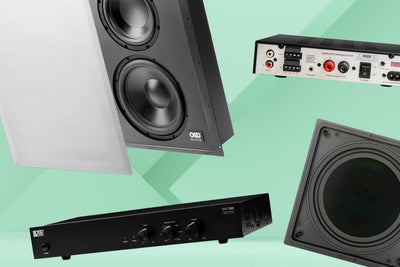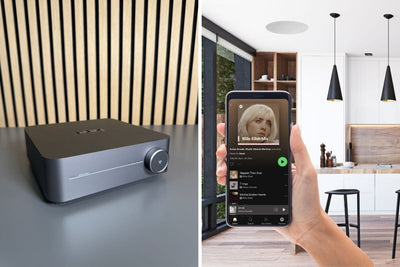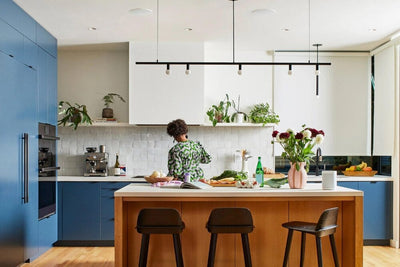Installing ceiling speakers throughout your home creates an immersive audio experience, but managing multiple speakers across different rooms can quickly become overwhelming.
That's where speaker switches come in, clever devices that give you complete control over your multi-room audio system whilst protecting your amplifier from damage.
A speaker switch lets you:
- Play music in the kitchen whilst the patio speakers are turned off, and vice versa.
- Safely power six speakers in a larger open-plan area without damaging your amplifier.
What Is a Speaker Switch?
A speaker switch (also called a speaker selector switch) is a device that allows you to connect multiple pairs of speakers to a single amplifier whilst controlling which speakers play at any given time.
Think of it as a sophisticated junction box that routes audio signals from your amplifier to different speaker zones throughout your home.
The below example shows how you could connect two rooms of ceiling speakers, a pair of garden speakers and some bookshelf speakers all from one Sonos AMP.
All speakers will play the same music, at the same volume, but you can easily turn each pair on or off allowing you to have all of them on, some of them on, or just one of them on.

Using speaker switches can often be more cost-effective and also more user-friendly in certain scenarios.
Sticking with the above wiring example, and with some references to my own homes audio setup, if you have a pair of ceiling speakers in your kitchen and pair outside the bi-fold doors on the patio, it's unlikely that you'll:
- Want to have different music playing outside compared to inside
- Want to have the outdoor speakers on all the time i.e when you're listing to music in the kitchen at night.
You could use two amplifiers and have two zones, but that means paying for two amplifiers!
The simple answer though is to add a speaker selector switch.
You can now have both speakers playing the same music, or just one of them.
You simply turn off the outdoor speakers until you need them!
All for an extra £159 instead of £319+ depending on your amplifier choice.
Pros & Cons of Speaker Switches
Before diving into the types and features, it's important to understand both the advantages and limitations of speaker switches for your ceiling speaker installation.
Advantages of Speaker Switches
- Cost-Effective Solution Speaker switches offer exceptional value by allowing you to use a single amplifier across multiple rooms. Rather than purchasing separate amplifiers for each zone, you can create a comprehensive multi-room audio system with just one quality amplifier and a speaker switch - significantly reducing your overall system cost.
- Simple Zone Control Managing your ceiling speakers becomes effortless with a speaker switch. You can easily select which rooms receive audio with the flip of a switch or press of a button, giving you instant control over your home's soundscape without complex wiring or expensive control systems.
- Connect More Speakers for Larger Rooms For larger spaces that require multiple ceiling speakers, switches allow you to connect several speakers to create fuller, more immersive sound coverage. This is particularly valuable in open-plan living areas, large kitchens, or entertainment rooms where a single pair of speakers might not provide adequate coverage.
Limitations of Speaker Switches
- Same Volume Throughout Active Zones One key limitation is that all connected speakers typically share the same volume level. If you're playing music in both the kitchen and living room, you cannot independently adjust the volume in each space - both zones will play at the same level as set on your amplifier.
- Same Music Throughout Active Zones Speaker switches route the same audio signal to all selected zones. You cannot play different music in different rooms simultaneously - whatever's playing from your source (radio, streaming service, or media player) will be heard in all active zones.
Protecting Your Amplifier
Another use case for using a speaker switch isn't the convenience of zones - it's protection.
When you connect multiple speakers directly to an amplifier, you're reducing the total impedance load.
Most home amplifiers are designed to handle 4-8 ohm loads, but adding extra speakers can drop this to dangerously low levels.
For example, connecting three pairs of 8 ohm ceiling speakers to an amplifier directly would cause it to over-power which can cause it to overheat and fail.
So there are quite a few times when you'd use an impedance matching speaker selector switch hidden out-of-sight simply to protect the amplifier.
Let's say you have a large open plan kitchen / dining room requiring six speakers. You don't need to turn each set on or off but you do need to protect the amplifier.
Simply connect them all to an impedance matching speaker selector switch hidden with the amplifier and you're safe!
Types of Speaker Switches

Manual Switches
These simple, affordable switches use manual toggle buttons to select speaker pairs.
They're perfect for smaller installations with 2 speaker zones and don't require any power source.
You can get a four zone version of this, but remember it has no impedance matching so you'd have issues if you turn on all zones at once.
We typically recommend them for split rooms i.e a bedroom + en-suite which both have 8 ohm speakers that could be safely directly connected to the amplifier.
Best for: Basic ceiling speaker setups with two pairs of 8 ohm speakers

Impedance Matching Switches
These more sophisticated switches automatically adjust impedance levels as you add or remove speakers from the circuit.
They include built-in protection circuits and often feature LED indicators to show which zones are active.
Best for: Larger installations with 6+ speaker zones, high-end ceiling speaker systems
Smart Speaker Switches
The premium option includes a smartphone app and voice control integration.
These switches offer the most flexibility and can integrate with smart home systems.
Whilst they are a little bit more expensive they are much better quality and are much better to use.
Audioflow smart speaker switches are an excellent example of this category, offering advanced features like app control and seamless integration with popular home automation platforms.
Best for: Whole-home ceiling speaker installations, tech-savvy users
Key Features to Look For
Impedance Protection
This is non-negotiable. Look for switches that maintain proper impedance levels regardless of how many speakers you have connected. The switch should prevent impedance from dropping below 4 ohms.
Power Handling
Ensure the switch can handle your amplifier's power output. Check both RMS (continuous) and peak power ratings to avoid bottlenecks in your system.
Number of Zones
Consider not just your current ceiling speaker installation, but potential future expansion. It's often more cost-effective to buy a switch with extra zones than to upgrade later.
Build Quality
Look for switches with gold-plated terminals, robust housing, and quality internal components. Cheap switches can introduce noise, distortion, or reliability issues.

Installation Considerations
Placement
Install your speaker switch in a central, accessible location.
If you've chosen a manual switch then you'll need to go to the switch to turn zones on and off regularly.
However, the Audioflow smart switches are app controlled - so you don't need to go to the switch to control it.
Wiring
Use high-quality speaker cable appropriate for your ceiling speaker installation.
Each individual speaker needs to wire back to the speaker selector switch.
The amplifier then wires into the speaker selector switches input.
So if you have six speakers around your house and one amplifier you'd expect to see 8 x two core cables. (six for the speakers and two from the amplifier)
For longer runs (common with ceiling speakers), consider 14 or 12-gauge wire to minimise signal loss.
Labelling
Clearly label each zone on your switch.
This seems obvious, but it's frustrating to guess which switch controls which room when you're entertaining guests.
Smart switches such as the Audioflow let you name each zone so you can easily understand which speakers you're turning on and off.

Common Mistakes to Avoid
Ignoring Impedance Matching
Simply connecting multiple ceiling speakers without proper impedance matching is the quickest way to damage your amplifier. Always use a switch with impedance protection.
Undersizing the Switch
Buying a switch that's barely adequate for your current setup leaves no room for expansion. Ceiling speaker installations often grow over time as homeowners add more zones.
Cheap Components
Whilst budget switches exist, they often introduce noise, have poor build quality, or lack proper protection circuits. Invest in quality components for your ceiling speaker system.
Poor Cable Management
Messy wiring makes troubleshooting difficult and can introduce interference. Use proper cable management and keep speaker wires away from power cables.
Final Thoughts
A proper speaker switch transforms your ceiling speaker installation from a simple audio system into a flexible, multi-zone entertainment solution.
By protecting your amplifier, providing zone control, and offering room for expansion, the right switch is an investment that pays dividends in both performance and peace of mind.
Whether you're planning a new ceiling speaker installation or upgrading an existing system, choosing the right speaker switch ensures you'll enjoy high-quality audio throughout your home for years to come.
Take time to assess your needs, invest in quality components, and don't forget to plan for future expansion - your ears (and your amplifier) will thank you.






